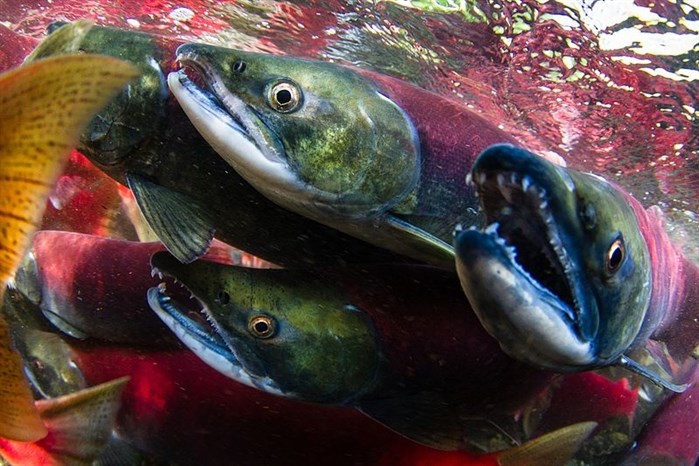
A photograph of sockeye salmon taken on July 30, 2013.
Image Credit: WIKIMEDIA COMMONS/Oregon State University
July 01, 2021 - 7:30 AM
Warm waters make a dangerous journey for sockeye salmon and one researcher is suggesting residents should avoid catching and releasing fish in general.
Anything above 24 C is generally lethal to fish like salmon and rainbow trout that people harvest in Okanagan Lake, said Okanagan Nation Alliance fisheries manager, Howie Wright.
With warmer waters, fish find refuge deeper in the lake’s thermocline layer, which changes with depth in the lake and is cooler than surface waters.
READ MORE: Sockeye fry released into streams and lakes across Okanagan
“When people do catch and release, it would be bringing them up to lethal temperatures, or if they escape up there, they have to get down as fast as possible. For recreational fishers, keep that in mind for Okanagan Lake,” Wright said.
Wright recommends with the hot temperatures to not catch and release fish as it places stress on the species.
Okanagan Lake surface temperatures have reached 26.7 C today, meaning the water is roughly the same temperature as ocean waters in parts of Florida.
Jacksonville recorded sea temperature at 26.7°C today, June 30, according to seatemperature.org.
Average monthly high temperatures for the lake in June usually hit a high of 17 C, according to World Weather Online. The lake will typically warm up in July and August, but even then only reaches highs of 23 C on average.
Spawning sockeye that are returning to the lake are experiencing a delayed migration because of the warm waters. Currently they can be found in the Columbia River by the mouth of the Okanagan River, which will provide limited opportunities to harvest them for ONA members at Okanagan Falls, Osoyoos Lake and at McIntyre Dam, Wright said.
Warmer river waters will also increase mortality rates for the fish, which prefer waters around 10 C.
“Their survival is about 35% from the mouth of the Columbia to the spawning grounds and we’ll likely see that lower,” he said, adding they could see survival rates as low as 5% this year due to the heated waters.
In the South Okanagan, a migration delay can be as early as now to late August, Wright said. With warmer waters later in the summer, the fish will spend more time in Okanagan, Skaha or Osoyoos Lake, but this year they’re doing the opposite as they stay in the Columbia River for longer periods of time.
“Hopefully it cools off here,” he said.
In the Thompson region, fish in Paul and Adams Lakes will likely be able to keep cool, said Don Holmes, limnologist with Lakeshore Environmental, an environmental consulting firm.
“But this is kind of scary when the fish start moving up the waters from the ocean. For the smolts it's not an issue, but we are praying for cooler weather," he said.
"Paul Lake is the warmest I've seen it in 30 years."
- With files from Levi Landry
To contact a reporter for this story, email Carli Berry or call 250-864-7494 or email the editor. You can also submit photos, videos or news tips to the newsroom and be entered to win a monthly prize draw.
We welcome your comments and opinions on our stories but play nice. We won't censor or delete comments unless they contain off-topic statements or links, unnecessary vulgarity, false facts, spam or obviously fake profiles. If you have any concerns about what you see in comments, email the editor in the link above.
News from © iNFOnews, 2021